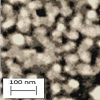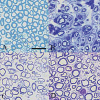Effects of Chitosan-Zinc Oxide Nanocomposite Conduit on Transected Sciatic Nerve: An Animal Model Study
- PMID: 29177170
- PMCID: PMC5694596
- DOI: 10.18869/acadpub.beat.5.4.521.
Effects of Chitosan-Zinc Oxide Nanocomposite Conduit on Transected Sciatic Nerve: An Animal Model Study
Abstract
Objective: To determine the effects of chitosan-zinc oxide nanocomposite conduit on transected sciatic nerve in animal model of rat.
Methods: Sixty male White Wistar rats were used in this study. A 10-mm sciatic nerve defect was bridged using a chitosan-zinc oxide nanocomposite conduit (CZON) filled with phosphate buffered saline. In chitosan group (CHIT) the chitosan conduit was filled with phosphate buffered saline solution. In sham-operated group (SHAM), sciatic nerve was exposed and manipulated. In transected group (TC), left sciatic nerve was transected and nerve cut ends were fixed in the adjacent muscle. The regenerated fibers were studied within 12 weeks after surgery.
Results: The behavioral and functional tests confirmed faster recovery of the regenerated axons in CZON group compared to Chitosan group (p<0.05). The mean ratios of gastrocnemius muscles weight were measured. There was statistically significant difference between the muscle weight ratios of CZON and Chitosan groups (p<0.05). Morphometric indices of regenerated fibers showed number and diameter of the myelinated fibers were significantly higher in CZON than in Chitosan. In immuohistochemistry, the location of reactions to S-100 in CZON was clearly more positive than Chitosan group.
Conclusion: Chitosan-zinc oxide nanocomposite conduit resulted in acceleration of functional recovery and quantitative morphometric indices of sciatic nerve.
Keywords: Chitosan-zinc oxide nanocomposite; Local; Peripheral nerve repair; Sciatic.
Conflict of interest statement
There are no conflicts of interests to declare.
Figures







Similar articles
-
Effect of Local Administration of Verapamil Combined with Chitosan Based Hybrid Nanofiber Conduit on Transected Sciatic Nerve in Rat.Bull Emerg Trauma. 2019 Jan;7(1):28-34. doi: 10.29252/beat-070104. Bull Emerg Trauma. 2019. PMID: 30719463 Free PMC article.
-
Regenerative Capacities of Chitosan-Nanoselenium Conduit on Transected Sciatic Nerve in Diabetic Rats: An Animal Model Study.Bull Emerg Trauma. 2020 Jan;8(1):10-18. doi: 10.29252/beat-080103. Bull Emerg Trauma. 2020. PMID: 32201697 Free PMC article.
-
Local Polyethylene Glycol in Combination with Chitosan Based Hybrid Nanofiber Conduit Accelerates Transected Peripheral Nerve Regeneration.J Invest Surg. 2016 Jun;29(3):167-74. doi: 10.3109/08941939.2015.1098758. Epub 2015 Dec 18. J Invest Surg. 2016. PMID: 26684915
-
Effect of in situ delivery of acetyl-L-carnitine on peripheral nerve regeneration and functional recovery in transected sciatic nerve in rat.Int J Surg. 2014 Dec;12(12):1409-15. doi: 10.1016/j.ijsu.2014.10.023. Epub 2014 Oct 28. Int J Surg. 2014. PMID: 25448663
-
Pulsed electromagnetic fields accelerate functional recovery of transected sciatic nerve bridged by chitosan conduit: an animal model study.Int J Surg. 2014 Dec;12(12):1278-85. doi: 10.1016/j.ijsu.2014.11.004. Epub 2014 Nov 11. Int J Surg. 2014. PMID: 25448645
Cited by
-
The Role of Dietary Nutrients in Peripheral Nerve Regeneration.Int J Mol Sci. 2021 Jul 10;22(14):7417. doi: 10.3390/ijms22147417. Int J Mol Sci. 2021. PMID: 34299037 Free PMC article. Review.
-
Effect of Local Administration of Verapamil Combined with Chitosan Based Hybrid Nanofiber Conduit on Transected Sciatic Nerve in Rat.Bull Emerg Trauma. 2019 Jan;7(1):28-34. doi: 10.29252/beat-070104. Bull Emerg Trauma. 2019. PMID: 30719463 Free PMC article.
-
Nanotopographical Features of Polymeric Nanocomposite Scaffolds for Tissue Engineering and Regenerative Medicine: A Review.Biomimetics (Basel). 2025 May 15;10(5):317. doi: 10.3390/biomimetics10050317. Biomimetics (Basel). 2025. PMID: 40422147 Free PMC article. Review.
References
-
- Chaiyasate K, Schaffner A, Jackson IT, Mittal V. Comparing FK-506 with basic fibroblast growth factor (b-FGF) on the repair of a peripheral nerve defect using an autogenous vein bridge model. J Invest Surg. 2009;22(6):401–5. - PubMed
-
- Lago N, Rodriguez FJ, Guzman MS, Jaramillo J, Navarro X. Effects of motor and sensory nerve transplants on amount and specificity of sciatic nerve regeneration. J Neurosci Res. 2007;85(12):2800–12. - PubMed
-
- Rosales-Cortes M, Peregrina-Sandoval J, Banuelos-Pineda J, Sarabia-Estrada R, Gomez-Rodiles CC, Albarran-Rodriguez E, et al. Immunological study of a chitosan prosthesis in the sciatic nerve regeneration of the axotomized dog. J Biomater Appl. 2003;18(1):15–23. - PubMed
-
- Wang A, Ao Q, Wei Y, Gong K, Liu X, Zhao N, et al. Physical properties and biocompatibility of a porous chitosan-based fiber-reinforced conduit for nerve regeneration. Bio Technol Lett. 2007;29(11):1697–702. - PubMed
-
- Wang G, Lu G, Ao Q, Gong Y, Zhang X. Preparation of cross-linked carboxymethyl chitosan for repairing sciatic nerve injury in rats. Biotechnol Lett. 2010;32(1):59–66. - PubMed
LinkOut - more resources
Full Text Sources
